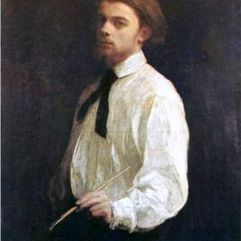

Henri Fantin-Latour
1836 - 1904
At the age of ten, Henri Fantin-Latour began painting with his father, Théodore Fantin-Latour (1805-1875). In 1850 he left Grenoble and moved to Paris to study under Horace Lecoq de Boisbaudran (1802-1897), an innovative and nontraditional instructor who developed and published his own unique teaching method based on painting and drawing from memory. Fantin studied with him for six years and then attended the École des Beaux-Arts for less than a year in 1854. Encouraged by J. A. M. Whistler (1834-1903), whom he met in 1858 at the Louvre, Fantin-Latour made several trips to London from 1859 to 1881, where he exhibited at the Royal Academy. London collectors appreciated his still lifes, and he began accepting numerous portrait commissions from English patrons. It was in London, through Whistler's brother-in-law Francis Seymour Haden (1818-1910), that Fantin first learned to etch. After his first Salon submissions were rejected in 1859, Fantin, in an effort to become better known in France, began exhibiting with his friend Manet (q.v.) and future impressionists Renoir (q.v.) and Monet (q.v.). In 1865 Fantin wrote collector Edwin Edwards: "We form a group and make noise because there are lots of painters about and one is easily overlooked. When we get together... we gain strength in numbers and grow more adventurous. I thought it could last. That was my mistake." Unlike the realists and the impressionists, Fantin did not paint out of doors; rather, he preferred literary subjects, still lifes, and portraits that could be painted in his studio. In addition to portraits and still lifes, he made numerous paintings and more than 150 prints that were fantasy works and dream visions, paving the way for symbolist artists. These works were inspired by allegorical and mythological subjects as well as motivated by contemporary German composers such as Schumann and Wagner. After Fantin's death in 1904, critic René-Marc Ferry wrote: "when he found realism too limited and stifling, he lost himself in dreams, but his dreams went no further than the windows of his studio. Deep down, he was first and foremost a studio artist."1
1. Druick and Hoog 1982, 28.
Text © The Cleveland Museum of Art, 2024















































